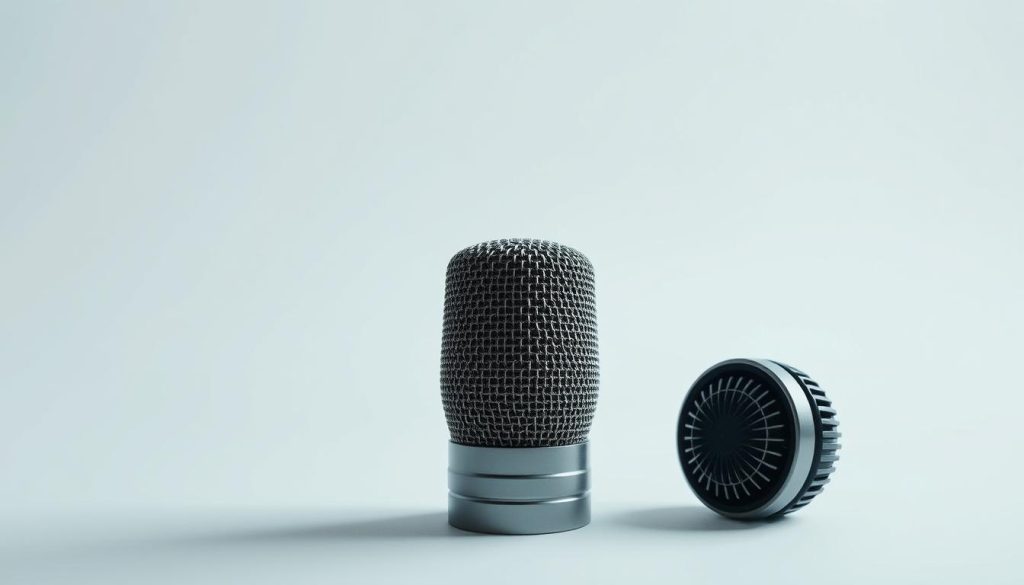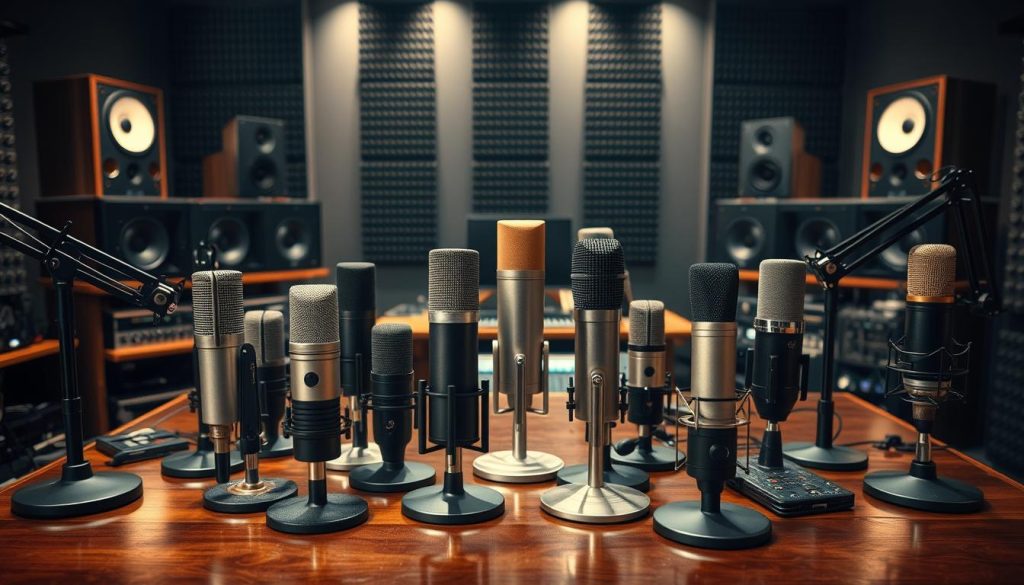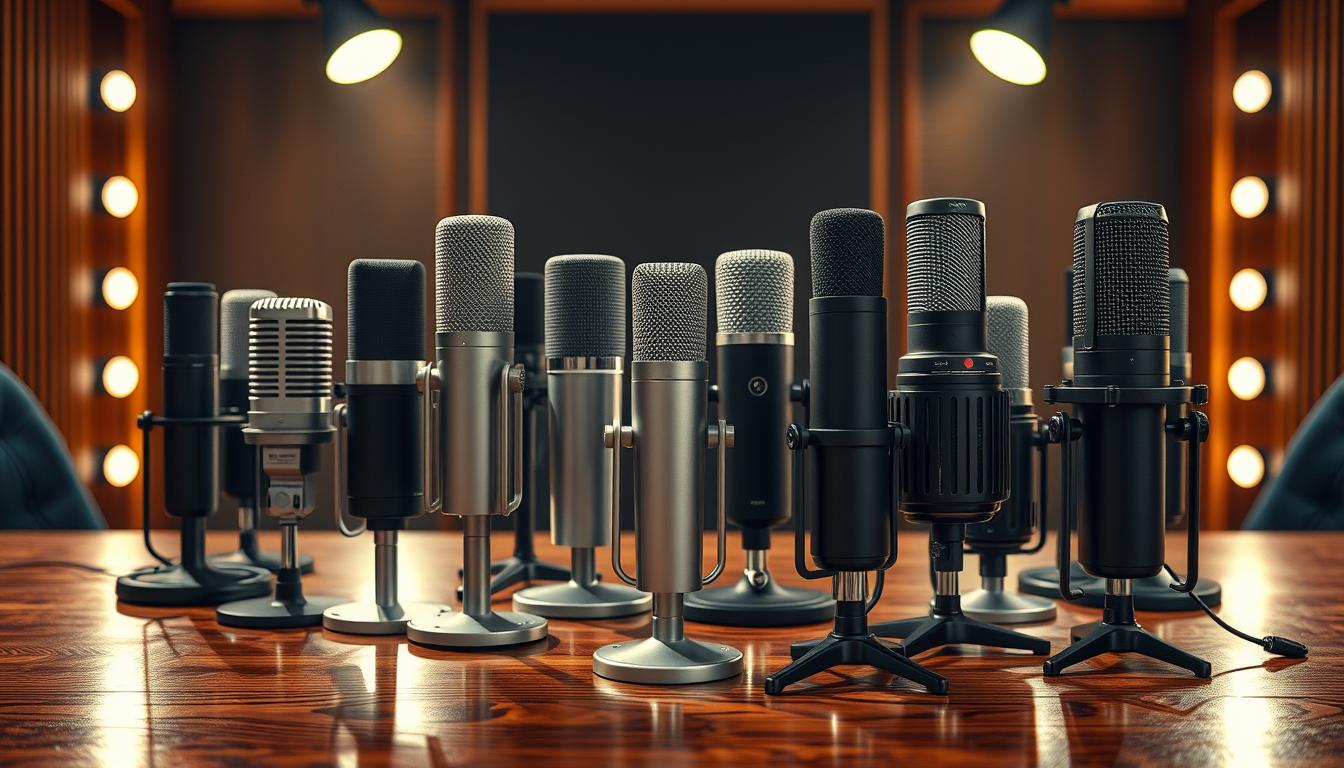As a pro sound engineer, I know how crucial the right microphone is for great audio. The right mic can change everything in your recording, whether it’s drums, guitars, acoustic instruments, or vocals. Here, I’ll share my top picks for mics that will improve your recordings and mixes.
I’ll talk about the different types of mics, the importance of diaphragm size, and the best mics for various instruments. By the end, you’ll know how to pick the perfect mic for your studio. This will help you make your recordings sound amazing.
Understanding the Different Types of Microphones
In the world of professional audio, there are many types of microphones. Sound engineers use them to get great audio. Each type has its own special features and uses. Let’s look at the main differences between them.
Dynamic Microphones
Dynamic microphones work by moving a conductive diaphragm in a magnetic field. They are tough and affordable. That’s why they’re often used for electric guitars and drums.
They’re not as sensitive as some others. But, they can handle loud sounds well.
Condenser Microphones
Condenser microphones use an electrically charged diaphragm to make sound. They pick up more detail and need phantom power. These mics are great for recording vocals and soft sounds.
Ribbon Microphones
Ribbon mics measure air movement to make sound. They give a smooth, natural sound. They’re perfect for recording brass, woodwinds, and strings.
USB Microphones
USB microphones connect directly to computers for recording. They’re easy to use for podcasters and home recorders. You don’t need an extra audio interface.
Knowing about these microphones helps sound engineers pick the best one for the job. It’s important for getting great sound in any recording setting. Understanding dynamic, condenser, ribbon, and USB mics makes a big difference in audio quality.
The Importance of Microphone Diaphragm Size

The size of a microphone’s diaphragm is key to getting the perfect sound. It’s important for both seasoned sound engineers and beginners. Knowing the differences between large, medium, and small diaphragm mics can change your audio production.
Large Diaphragm Microphones
Large diaphragm mics are great for vocals and orchestral instruments. They capture a warm, full sound. These mics are perfect for recording lead vocals or grand piano.
Medium Diaphragm Microphones
Medium diaphragm mics offer a balance of sound. They have clear high notes and a full low sound. These mics work well for many instruments, like acoustic guitars and drum overheads.
Small Diaphragm Microphones
Small diaphragm condensers are known for their fast response and clear high notes. They’re ideal for capturing the details of instruments like acoustic guitars and drum cymbals. Their quick response gives a crisp, clear sound.
Knowing the strengths of each diaphragm size helps sound engineers pick the right mic. This is true for microphone diaphragm size comparison, large vs medium vs small diaphragm mics, or finding the best mic diaphragm size for the job.
Microphone Applications: Best Picks for Different Instruments
As a sound engineer, I’ve learned that the key to perfect audio is knowing each instrument’s needs. Recording drums, electric guitars, acoustic guitars, or vocals requires the right mic and placement. The right choice can change everything.
Drum Recording Setup
For drums, I suggest using small condenser mics for overheads, a cardioid dynamic for the snare, and a large condenser for the kick. This setup captures the full sound of the drums while keeping it clear and balanced.
Recording Electric Guitars
For electric guitars, I use a dynamic mic close to the cabinet and a large condenser a few feet back. This combo gives a great mix of the guitar’s bite and fullness. It captures the guitar’s tone well while keeping the sound cohesive.
Acoustic Guitar Recording
For acoustic guitars, I often use a small condenser mic at the 12th fret. This spot captures the instrument’s details and natural resonance. It results in a warm, detailed recording.
Vocal Recording
For vocals, a large condenser mic is usually best. But, I always suggest trying different mics to find what the singer likes best. The right mic can highlight the singer’s unique sound.
Knowing what each instrument needs helps sound engineers pick the best mics and placements. This knowledge is key to making recordings that truly capture the music’s essence.
Microphone Polar Patterns Demystified
As a sound engineer, knowing about microphone polar patterns is key. These patterns tell us how a mic picks up sound from different angles. We’ll look at cardioid, omnidirectional, and figure-8 patterns.
Cardioid Polar Pattern
The cardioid pattern is very common in audio work. It’s great at ignoring sounds not coming from directly in front of it. This makes it perfect for focusing on one sound in a noisy place.
It’s often used for vocals, instruments, and more. This is when you want to capture just one sound and not the background.
Omnidirectional Polar Pattern
On the other hand, omnidirectional mics catch sound from all around. This gives a very natural sound, including the room’s echo and other sounds around you. They’re great for recording things like acoustic instruments or groups of people.
Figure-8 Polar Pattern
The figure-8 pattern is very directional, picking up sound from both the front and back equally. It’s perfect for getting ambient sounds or adding depth to recordings. Stereo recordings often use two figure-8 mics to make the sound feel more real.
Knowing about microphone polar patterns helps sound engineers get the sound they want. They can use a cardioid pattern to focus on one sound, an omnidirectional pattern for a natural sound, or a figure-8 pattern for depth.
Best Microphones for Sound Engineers | Expert Picks

I’ve worked with many professional-grade microphones as a sound engineer. I know the best ones for making your recordings sound great. These mics are perfect for live shows or capturing every detail in the studio.
The Shure SM57 is a favorite of mine. It’s great for live shows and recording drums and guitars. For vocals and acoustic sounds, the Rode NT1 is perfect. It gives you a clear and detailed sound.
The Neumann TLM 103 is top-notch for vocals and piano. It captures sounds naturally and clearly. The Royer R-121 adds a vintage touch to guitars and brass. The Shure Beta 58A is great for lead vocals because it cuts through the noise.
These microphones are essential for any sound engineer, new or experienced. They will improve your recordings a lot. Get these mics and make your recordings sound amazing.
Factors to Consider When Choosing a Microphone
Choosing the right microphone for your studio is important. First, know the type: dynamic, condenser, or ribbon. Each type has its own sound and works best with certain sounds and settings.
Think about the microphone’s diaphragm size too. It affects the sound’s warmth and clarity. Big diaphragms give a warm sound, while small ones capture details well.
Don’t forget about polar patterns. They decide how the mic picks up sound. Make sure it matches your recording needs with cardioid, omnidirectional, or figure-8 patterns.
Also, consider the mic’s build, how it connects, and its price. You want a mic that’s reliable and gives great sound. Keep these things in mind to find the best mic for you.

